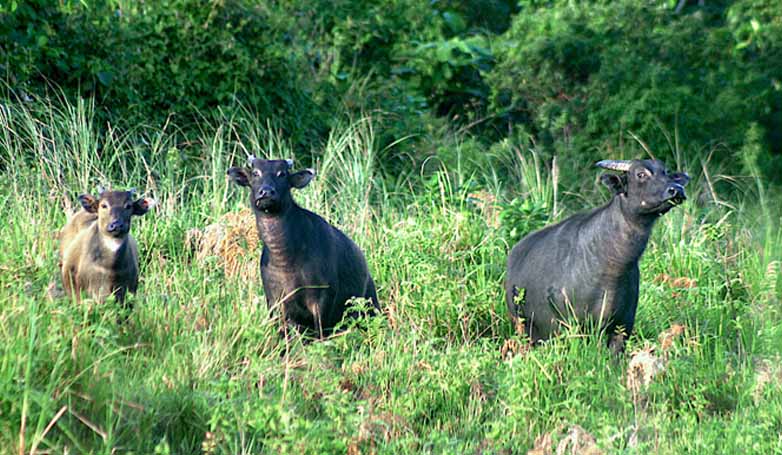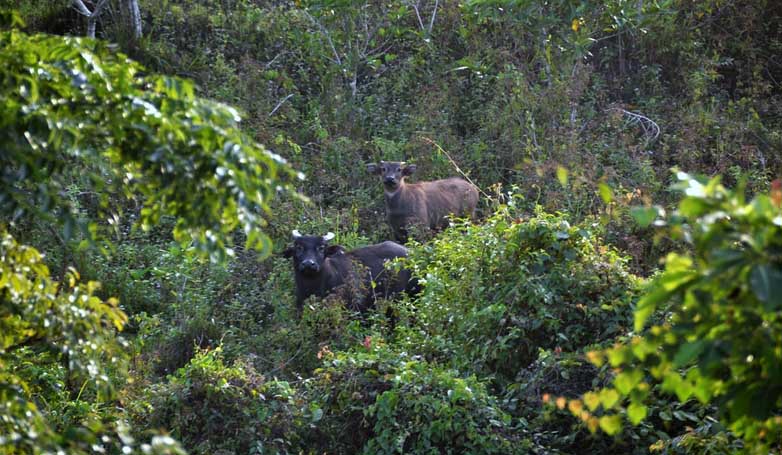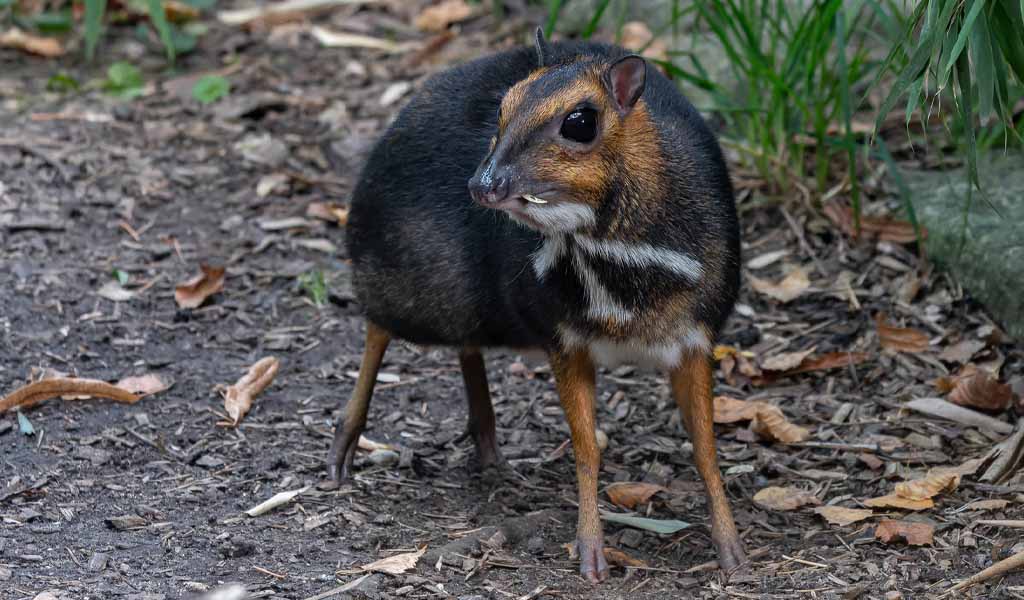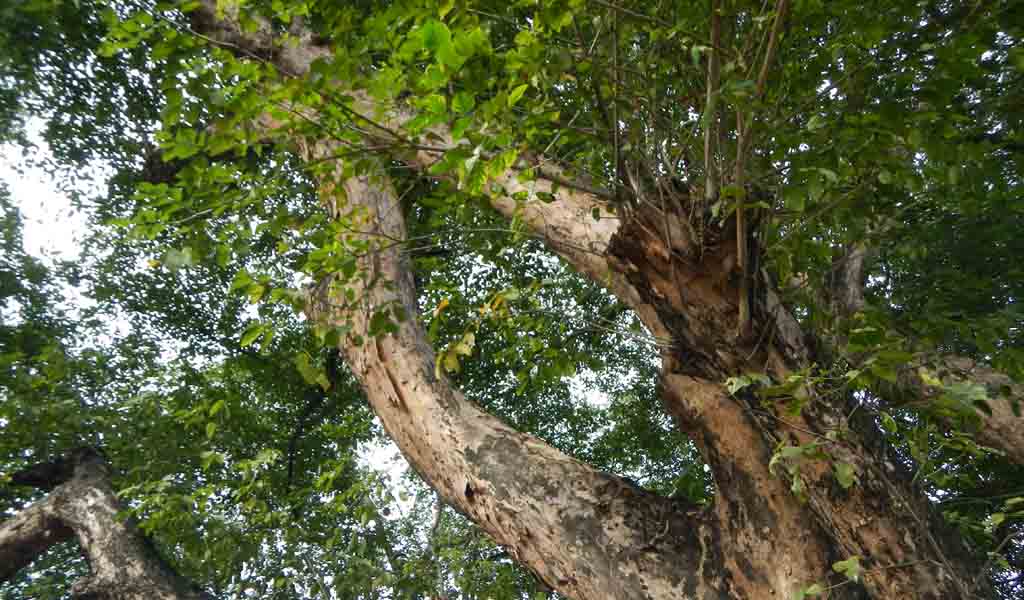The Philippine Tamaraw – An Overview

The Philippine Tamaraw, scientifically known as Bubalus mindorensis, is a small, critically endangered bovine species native to the island of Mindoro in the Philippines. Distinguished by its robust and compact build, the tamaraw has a dark brown to grayish coat, and its distinctive features include short, V-shaped horns and a stocky frame. Standing about three feet tall at the shoulder and weighing between 180 to 300 kilograms, the tamaraw is smaller than the more common carabao, or water buffalo, which is also found in the Philippines. This elusive herbivore prefers dense forest habitats and mountainous regions, where it grazes on grasses, bamboo shoots, and other vegetation.
The tamaraw’s population has drastically declined over the past century due to habitat loss, hunting, and disease. Conservation efforts are underway to protect this unique species, which is a symbol of pride and biodiversity for the Philippines. Organizations like the Tamaraw Conservation Program are working tirelessly to monitor and preserve the remaining tamaraw population, which is estimated to be less than 500 individuals. By implementing protective measures, habitat restoration, and public awareness campaigns, these conservationists hope to ensure the survival of the Philippine tamaraw for future generations.
Habitat and Distribution

The Philippine Tamaraw, endemic to the island of Mindoro, thrives in dense tropical forests and grassy plains. Historically, these majestic creatures roamed the entire island, but their current distribution is confined to fragmented patches within protected areas such as the Mounts Iglit-Baco National Park and the Aruyan-Malati Tamaraw Reservation. These regions provide the essential cover and food sources the tamaraw needs for survival, including a variety of grasses, bamboo shoots, and young leaves.
The tamaraw’s habitat is characterized by its rugged terrain and diverse vegetation, which offer both sustenance and protection from predators and human encroachment. Unfortunately, the tamaraw’s habitat has been significantly reduced due to agricultural expansion, logging, and infrastructure development. Efforts to preserve and restore their natural environment are critical for the tamaraw’s survival. Conservation programs are focused on habitat management and restoration, ensuring that these areas remain safe havens for the tamaraw to live and breed.
Physical Characteristics

The Philippine Tamaraw, Bubalus mindorensis, is a distinctive and robust bovine species, noted for its smaller size compared to other buffalo species. Adult tamaraws stand about three feet tall at the shoulder and weigh between 180 to 300 kilograms, making them compact yet sturdy creatures. Their most recognizable feature is their V-shaped horns, which are relatively short but thick and sharp, providing a formidable means of defense against predators.
The tamaraw’s coat is typically dark brown to grayish, becoming darker and coarser with age. They have a stocky build with strong, muscular limbs, which are well-suited for navigating the dense forests and rugged terrains of Mindoro. Their facial features include a broad forehead, large expressive eyes, and small, rounded ears, giving them a somewhat endearing appearance despite their wild nature. These physical traits not only distinguish the tamaraw from other bovines but also highlight their adaptability to their natural habitat.
Diet and Behavior
The Philippine Tamaraw is a herbivore with a diet primarily consisting of grasses, bamboo shoots, and various herbaceous plants. They forage in the early morning and late afternoon, avoiding the heat of the midday sun. Tamaraws are known to have a preference for young, tender shoots and leaves, which provide the necessary nutrients for their survival in the wild. Their grazing habits help maintain the ecological balance of their habitat by promoting new plant growth and preventing overgrowth of certain vegetation types.
In terms of behavior, tamaraws are generally solitary animals, especially adults, which is a contrast to the more social behavior observed in other buffalo species. However, young tamaraws may stay with their mothers for up to two years before venturing off on their own. Tamaraws are known to be territorial, using their horns and scent marking to establish their range. They are also cautious and elusive, often retreating into dense vegetation to avoid potential threats. This reclusive nature, combined with their solitary habits, makes them difficult to study and monitor, posing additional challenges for conservation efforts. Despite their elusive behavior, tamaraws can become aggressive if threatened, using their sharp horns and strong build to defend themselves.
Conservation Status and Threats Update
| Year | Estimated Population |
|---|---|
| 2020 | Less than 250 |
| 2021 | Less than 250 |
| 2022 | Less than 250 |
| 2023 | Less than 250 |
| 2024 | Less than 250 |
The estimated population of the Philippine Tamaraw is less than 250 mature individuals, according to the International Union for Conservation of Nature (IUCN). This low population number places them at a critically endangered status, meaning they face an extremely high risk of extinction in the wild.
There are several factors contributing to the decline in the Philippine Tamaraw population. Habitat loss due to deforestation and conversion of land for agriculture is a major threat. Additionally, hunting and poaching of Tamaraws for meat and trophies have significantly reduced their numbers.
Diseases, particularly those transmitted from domestic livestock, pose another threat. Tamaraws are susceptible to diseases carried by cattle, and contact with domestic livestock increases the risk of disease transmission to the already vulnerable Tamaraw population.
Conservation Efforts
Conservation efforts for the Philippine Tamaraw have become a critical focus due to its status as a critically endangered species. With the population estimated to be less than 500 individuals, intensive measures are necessary to prevent their extinction. The Tamaraw Conservation Program (TCP), initiated by the Philippine government, plays a pivotal role in these efforts. The program includes habitat preservation, anti-poaching patrols, and public education campaigns to raise awareness about the tamaraw’s plight and the importance of biodiversity.
Key initiatives involve habitat restoration projects aimed at rehabilitating degraded areas and expanding the protected zones where tamaraws can thrive. Collaboration with local communities is essential, as conservationists work to promote sustainable land use practices that do not encroach on the tamaraw’s habitat. Additionally, research and monitoring are integral components of the conservation strategy. Tracking the tamaraw population through field surveys and technological tools like camera traps helps gather crucial data on their numbers, health, and behavior, informing more effective conservation strategies.
International organizations and wildlife conservation groups also support these efforts, providing funding and expertise. By strengthening legal protections, enhancing enforcement against illegal hunting, and fostering community involvement, these combined efforts aim to create a sustainable future for the Philippine Tamaraw. The ultimate goal is not only to stabilize the population but to increase it, ensuring that this unique species continues to be a symbol of the rich biodiversity of the Philippines.
How You Can Help

Supporting the conservation of the Philippine Tamaraw is a vital endeavor that requires collective effort from individuals, communities, and organizations worldwide. One of the most effective ways to help is by donating to conservation programs such as the Tamaraw Conservation Program (TCP). These donations fund essential activities like habitat restoration, anti-poaching patrols, and scientific research, all of which are critical to protecting and increasing the tamaraw population.
Spread the Word
Another way to contribute is by raising awareness about the tamaraw and its endangered status. Sharing information on social media, organizing community events, and educating others about the importance of biodiversity and wildlife conservation can help garner broader support for conservation efforts. Engaging with local conservation groups and participating in volunteer programs can also make a significant impact. By getting involved, you can help monitor tamaraw populations, assist in habitat restoration projects, and support public education initiatives.
Support Conservation Efforts
Additionally, advocating for stronger environmental policies and legal protections for the tamaraw and its habitat is crucial. Contacting local representatives and supporting legislation that promotes wildlife conservation and sustainable land use practices can help create a more favorable environment for tamaraw survival. By taking these actions, you can play a direct role in ensuring that the Philippine Tamaraw continues to thrive for future generations.
Preserving the Legacy of the Philippine Tamaraw
The tamaraw is more than just an animal; it’s a symbol of the Philippines’ rich biodiversity. Saving it from extinction is about preserving a national treasure, ensuring future generations can witness this remarkable creature in its natural habitat. By working together, we can rewrite the tamaraw’s story, transforming it from one of struggle to a tale of enduring resilience and successful conservation. Remember, every action, big or small, contributes to a brighter future for the mighty tamaraw. Must see the majestic Philippine Eagle.
FAQs About Philippine Tamaraw
1. Why is the Philippine Tamaraw important?
The Philippine Tamaraw is a symbol of Philippine biodiversity and a flagship species for conservation in the country. Its conservation helps protect the unique ecosystems of Mindoro and promotes the importance of preserving endangered species globally.
2. Can I see the Philippine Tamaraw in the wild?
While the Philippine Tamaraw is a rare sight in the wild due to its critically endangered status, guided tours in Mounts Iglit-Baco National Park offer a chance to spot these elusive animals. However, sightings are not guaranteed.
3. How long do Philippine Tamaraws live?
In the wild, Philippine Tamaraws can live up to 20 years or more, while in captivity, they may live longer.
4. Are there any other buffalo species in the Philippines?
No, the Philippine Tamaraw is the only buffalo species native to the Philippines. However, the domestic water buffalo (carabao) is widely raised in the country.







